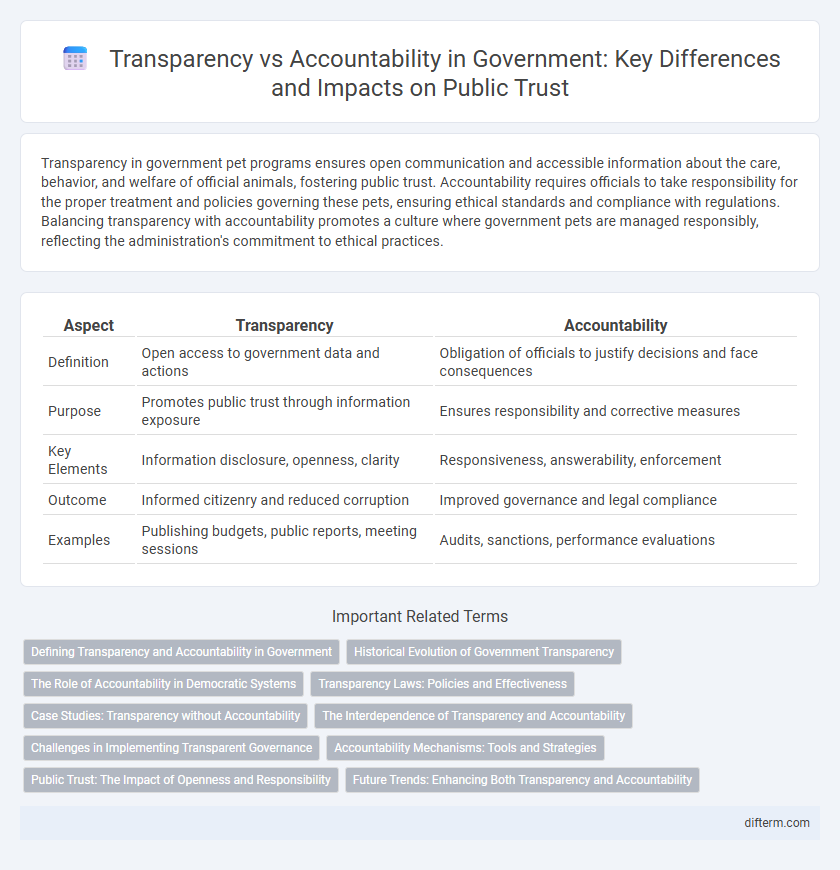Transparency in government pet programs ensures open communication and accessible information about the care, behavior, and welfare of official animals, fostering public trust. Accountability requires officials to take responsibility for the proper treatment and policies governing these pets, ensuring ethical standards and compliance with regulations. Balancing transparency with accountability promotes a culture where government pets are managed responsibly, reflecting the administration's commitment to ethical practices.
Table of Comparison
| Aspect | Transparency | Accountability |
|---|---|---|
| Definition | Open access to government data and actions | Obligation of officials to justify decisions and face consequences |
| Purpose | Promotes public trust through information exposure | Ensures responsibility and corrective measures |
| Key Elements | Information disclosure, openness, clarity | Responsiveness, answerability, enforcement |
| Outcome | Informed citizenry and reduced corruption | Improved governance and legal compliance |
| Examples | Publishing budgets, public reports, meeting sessions | Audits, sanctions, performance evaluations |
Defining Transparency and Accountability in Government
Transparency in government entails the open disclosure of policies, decisions, and financial activities, enabling citizens to access relevant information freely. Accountability involves the obligation of government officials to explain and justify their actions, ensuring responsibility for outcomes and adherence to laws. Both concepts are fundamental for fostering trust, preventing corruption, and promoting effective governance.
Historical Evolution of Government Transparency
Government transparency has evolved significantly since the early 20th century, with key milestones including the Freedom of Information Act (FOIA) enacted in 1966, which established citizens' rights to access government records. Historical shifts toward transparency were driven by societal demands for openness amid scandals such as Watergate, emphasizing the need for governmental accountability. The digital age further accelerated transparency through online data portals, enhancing public access to information and reinforcing democratic governance.
The Role of Accountability in Democratic Systems
Accountability in democratic systems ensures that government officials remain answerable to the public and legislative bodies, reinforcing trust in public institutions. Transparency facilitates this process by providing citizens with access to information critical for evaluating government actions and decisions. Effective accountability mechanisms, such as independent audits and public oversight committees, are essential for upholding democratic principles and preventing corruption.
Transparency Laws: Policies and Effectiveness
Transparency laws, such as the Freedom of Information Act (FOIA) and Open Government Data initiatives, aim to provide public access to government records and decision-making processes, fostering open governance. These policies have proven effective in reducing corruption and enhancing public trust by mandating timely disclosure and clear reporting requirements. However, the impact of transparency laws depends on robust enforcement mechanisms and the ease with which citizens can request and receive information.
Case Studies: Transparency without Accountability
Case studies of transparency without accountability often reveal increased public data access failing to curb corruption or improve governance outcomes. For example, the publication of government spending reports in countries like Brazil exposed misuse of funds yet lacked enforcement mechanisms to hold officials responsible. These instances highlight that transparency initiatives must be paired with robust accountability measures such as audits, sanctions, and active civil society engagement to achieve meaningful reform.
The Interdependence of Transparency and Accountability
Transparency and accountability are fundamentally interdependent pillars of effective government, as transparency provides the public access to information necessary for evaluating government actions, while accountability ensures that officials are held responsible for their decisions and policies. Transparent disclosure of budgets, legislative processes, and administrative procedures empowers citizens and watchdog organizations to monitor and demand accountability, preventing corruption and misuse of public resources. The synergy between transparency and accountability strengthens democratic governance by fostering trust, enabling informed participation, and promoting ethical conduct within public institutions.
Challenges in Implementing Transparent Governance
Implementing transparent governance faces challenges such as resistance from entrenched bureaucracies and the lack of robust technological infrastructure for open data dissemination. Government officials often struggle with balancing transparency and protecting sensitive information, complicating accountability measures. Moreover, limited public awareness and engagement hinder effective monitoring and enforcement of transparency initiatives.
Accountability Mechanisms: Tools and Strategies
Accountability mechanisms in government include performance audits, public reporting, and independent oversight bodies that ensure officials adhere to legal and ethical standards. These tools facilitate the evaluation of government actions and promote responsibility by making processes verifiable and consequences enforceable. Strategies such as citizen engagement platforms and whistleblower protections strengthen accountability by enabling public scrutiny and timely intervention against misconduct.
Public Trust: The Impact of Openness and Responsibility
Transparency enhances public trust by providing citizens with clear access to government actions and decisions, fostering an informed electorate. Accountability ensures that officials are held responsible for their conduct, reinforcing confidence in institutional integrity. Together, openness and responsibility create a robust framework that strengthens democratic governance and public legitimacy.
Future Trends: Enhancing Both Transparency and Accountability
Emerging technologies such as blockchain and AI-driven analytics are revolutionizing government transparency by enabling real-time access to data and fostering citizen engagement. Enhanced transparency tools facilitate proactive accountability by allowing stakeholders to monitor government actions and financial flows more accurately. Future government frameworks will increasingly integrate these innovations to create a synergistic model that strengthens both transparency and accountability in public administration.
transparency vs accountability Infographic

 difterm.com
difterm.com